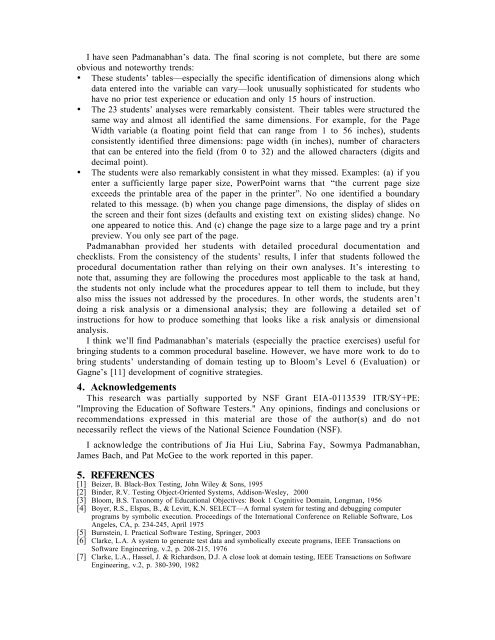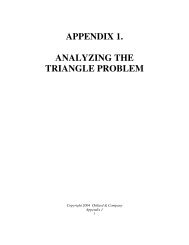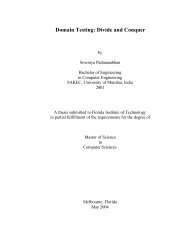Teaching Domain Testing: A Status Report - Testing Education
Teaching Domain Testing: A Status Report - Testing Education
Teaching Domain Testing: A Status Report - Testing Education
You also want an ePaper? Increase the reach of your titles
YUMPU automatically turns print PDFs into web optimized ePapers that Google loves.
I have seen Padmanabhan’s data. The final scoring is not complete, but there are some<br />
obvious and noteworthy trends:<br />
• These students’ tables—especially the specific identification of dimensions along which<br />
data entered into the variable can vary—look unusually sophisticated for students who<br />
have no prior test experience or education and only 15 hours of instruction.<br />
• The 23 students’ analyses were remarkably consistent. Their tables were structured the<br />
same way and almost all identified the same dimensions. For example, for the Page<br />
Width variable (a floating point field that can range from 1 to 56 inches), students<br />
consistently identified three dimensions: page width (in inches), number of characters<br />
that can be entered into the field (from 0 to 32) and the allowed characters (digits and<br />
decimal point).<br />
• The students were also remarkably consistent in what they missed. Examples: (a) if you<br />
enter a sufficiently large paper size, PowerPoint warns that “the current page size<br />
exceeds the printable area of the paper in the printer”. No one identified a boundary<br />
related to this message. (b) when you change page dimensions, the display of slides on<br />
the screen and their font sizes (defaults and existing text on existing slides) change. No<br />
one appeared to notice this. And (c) change the page size to a large page and try a print<br />
preview. You only see part of the page.<br />
Padmanabhan provided her students with detailed procedural documentation and<br />
checklists. From the consistency of the students’ results, I infer that students followed the<br />
procedural documentation rather than relying on their own analyses. It’s interesting to<br />
note that, assuming they are following the procedures most applicable to the task at hand,<br />
the students not only include what the procedures appear to tell them to include, but they<br />
also miss the issues not addressed by the procedures. In other words, the students aren’t<br />
doing a risk analysis or a dimensional analysis; they are following a detailed set of<br />
instructions for how to produce something that looks like a risk analysis or dimensional<br />
analysis.<br />
I think we’ll find Padmanabhan’s materials (especially the practice exercises) useful for<br />
bringing students to a common procedural baseline. However, we have more work to do to<br />
bring students’ understanding of domain testing up to Bloom’s Level 6 (Evaluation) or<br />
Gagne’s [11] development of cognitive strategies.<br />
4. Acknowledgements<br />
This research was partially supported by NSF Grant EIA-0113539 ITR/SY+PE:<br />
"Improving the <strong>Education</strong> of Software Testers." Any opinions, findings and conclusions or<br />
recommendations expressed in this material are those of the author(s) and do not<br />
necessarily reflect the views of the National Science Foundation (NSF).<br />
I acknowledge the contributions of Jia Hui Liu, Sabrina Fay, Sowmya Padmanabhan,<br />
James Bach, and Pat McGee to the work reported in this paper.<br />
5. REFERENCES<br />
[1] Beizer, B. Black-Box <strong>Testing</strong>, John Wiley & Sons, 1995<br />
[2] Binder, R.V. <strong>Testing</strong> Object-Oriented Systems, Addison-Wesley, 2000<br />
[3] Bloom, B.S. Taxonomy of <strong>Education</strong>al Objectives: Book 1 Cognitive <strong>Domain</strong>, Longman, 1956<br />
[4] Boyer, R.S., Elspas, B., & Levitt, K.N. SELECT—A formal system for testing and debugging computer<br />
programs by symbolic execution. Proceedings of the International Conference on Reliable Software, Los<br />
Angeles, CA, p. 234-245, April 1975<br />
[5] Burnstein, I. Practical Software <strong>Testing</strong>, Springer, 2003<br />
[6] Clarke, L.A. A system to generate test data and symbolically execute programs, IEEE Transactions on<br />
Software Engineering, v.2, p. 208-215, 1976<br />
[7] Clarke, L.A., Hassel, J. & Richardson, D.J. A close look at domain testing, IEEE Transactions on Software<br />
Engineering, v.2, p. 380-390, 1982








